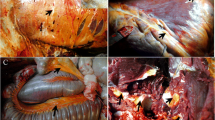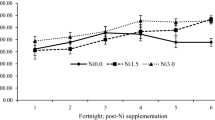Abstract
Nutrition is the foundation of health and well-being that goes hand in hand with horse breeding. Improper nutrition plays an important role in the development of various diseases in horses. Changes in feed type and quality can vary greatly and predispose horses to a range of problems. The rations to be applied to horses in breeding enterprises are the main element of animal welfare and business profitability. This chapter aims to contribute positively to the existing literature by evaluating some important diseases (equine metabolic syndrome, laminitis, paralytic myoglobinuria, and colic) in horses with malnutrition in their etiology.
Access this chapter
Tax calculation will be finalised at checkout
Purchases are for personal use only
Similar content being viewed by others
References
Abutarbush SM, Carmalt JL, Shoemaker RW (2005) Causes of gastrointestinal colic in horses in western Canada: 604 cases (1992 to 2002). Can Vet J 46:800–805
Archer DC, Proudman CJ (2006) Epidemiological clues to preventing colic. Vet J 172(1):29–39
Asplin KE, Sillence MN, Pollitt CC et al (2007) Induction of laminitis by prolonged hyperinsulinaemia in clinically normal ponies. Vet J 174(3):530–535
Auer JA (2006) Musculoskeletal system. In: Fathman L (ed) Equine surgery, 3rd edn. Missouri, Saunders Elsevier, pp 1213–1217
Bajpeyi S, Tanner CJ, Slentz CA et al (2009) Effect of exercise intensity and volume on persistence of insulin sensitivity during training cessation. J Appl Physiol 106(4):1079–1085
Baran MS, Alkan O (2014) Tayların beslenmesi ve beslenme hastalıkları. Uludağ Univ Vet Fak Derg 33(1–2):63–69
Başoğlu A, Sevinç M (2004) Evcil hayvanlarda metabolik ve endokrin hastalıklar. Pozitif matbaacılık, Konya, pp 213–224
Bilal T (2003) Tek tırnaklıların iç hastalıkları ve beslenmesi. İstanbul Üniversitesi basım ve yayınevi müdürlüğü, İstanbul, pp 473–481
Carter RA, Geor RJ, Staniar WB et al (2009) Apparent adiposity assessed by standardised scoring systems and morphometric measurements in horses and ponies. Vet J 179(2):204–210
Çelik Ş, Coşkun F, Yılmaz O (2015) Türk Alaca Atlarda Yaş Grubuna Göre Vücut Ölçülerinin Farklı Ortogonal Karşılaştırma Yöntemleriyle İncelenmesi. ÇOMÜ Ziraat Fak derg 3(1):81–87
Cohen N, Gibbs P, Woods A (1999) Dietary and other management factors associated with equine colic. J Am Vet Med Assoc 45:96–98
Colic A (2008) An age-old problem. CEH Horse Report 26(1):2–11
Crandall JP, Knowler WC, Kahn SE et al (2008) The prevention of type 2 diabetes. Nat Clin Pract Endocrinol Metab 4(7):382–393
Curtis L, Burford JH, England GC et al (2019) Risk factors for acute abdominal pain (colic) in the adult horse: a scoping review of risk factors, and a systematic review of the effect of management-related changes. PLoS One 14(7):e0219307
de Laat MA, Reiche DB, Sillence MN et al (2019) Incidence and risk factors for recurrence of endocrinopathic laminitis in horses. J Vet Intern Med 33(3):1473–1482
Demirtaş R, Şahinduran Ş, Akar A (2019) Atlarda Paralitik Myoglobinüri/Azotüri. International Young Researchers Student Congress 28–30 November 2019 Burdur, Turkey, p 101–106
Durham AE, Frank N, McGowan CM et al (2019) ECEIM consensus statement on equine metabolic syndrome. J Vet Intern Med 33(2):335–349
Dybkjær E, Steffensen KF, Honoré ML et al (2022) Short-term survival rates of 1,397 horses referred for colic from 2010 to 2018. Acta Vet Scand 64(1):1–9
Eades SC, Holm EMS, Moore RM (2002) A review of the pathophysiology and treatment of acute laminitis: pathophysiologic and therapeutic implications of endothelin-1. AAEP Proceedings 48:353–361
Egenvall A, Penell JC, Bonnett BN et al (2006) Mortality of Swedish horses with complete life insurance between 1997 and 2000: variations with sex, age, breed and diagnosis. Vet Rec 158(12):397–406. https://doi.org/10.1136/vr.158.12.397. PMID: 16565338
EL-Deeb WM, El-Bahr SM (2014) Selected biochemical indicators of equine rhabdomyolysis in Arabian horses: acute phase proteins and trace elements. J Equine Vet Sci 34(4):484–488
Frank N (2009) Equine metabolic syndrome. J Equine Vet Sci 29(5):259–267
Frank N, Sommardahl CS, Eiler H et al (2005) Effects of oral administration of levothyroxine sodium on concentrations of plasma lipids, concentration and composition of very-low-density lipoproteins, and glucose dynamics in healthy adult mares. Am J Vet Res 66(6):1032–1038
Frank N, Geor RJ, Bailey SR et al (2010) Equine metabolic syndrome. J Vet Intern Med 24(3):467–475
Furr MO, Lessard P, Iı NAW (1995) Development of a colic severity score for predicting the outcome of equine colic. Vet Surg 24(2):97–101
Goodyear LJ, Kahn BB (1998) Exercise, glucose transport, and insulin sensitivity. Annu Rev Med 49:235
Harris PA, Rivero JLL (2017) Nutritional considerations for equine rhabdomyolysis syndrome. Equine Vet Educ 29(8):459–465
Harris P, Bailey SR, Elliott J et al (2006) Countermeasures for pasture-associated laminitis in ponies and horses. J Nutr 136(7):2114–2121
Hillyer MH, Taylor FG, Proudman CJ et al (2002) Case control study to identify risk factors for simple colonic obstruction and distension colic in horses. Equine Vet J 34(5):455–463. https://doi.org/10.2746/042516402776117746
Hudson JM, Cohen ND, Gibbs PG et al (2001) Feeding practices associated with colic in horses. J Am Vet Med Assoc 219(10):1419–1425
Hunt RJ (1993) A retrospective evaluation of laminitis in horses. Equine Vet J 25(1):61–64
Huskamp B, Kopf N, Scheidemann W et al (1999) Magen-Darm-Trakt. Handbuch Pferde Praxis. Ferdinand Enke Verlag, Stuttgart, pp 411–502
Hutley L, Prins JB (2005) Fat as an endocrine organ: relationship to the metabolic syndrome. Am J Med Sci 330(6):280–289
Johnson A (2003) Ergebnisse von 1431 stationär behandelten Kolikpatienten, unter besonderer Berücksichtigung der 285 chirurgisch versorgten Pferde, in den Jahren 1990 bis 1997 in der Klinik für Pferde, allgemeine Chirurgie und Radiologie der Freien Universität Berlin, Doctoral dissertation
Johnson PJ, Messer NT, Slight SH et al (2004) Endocrinopathic laminitis in the horse. Clin Tech Equine Pract 3(1):45–56
Johnson JL, Slentz CA, Houmard JA et al (2007) Exercise training amount and intensity effects on metabolic syndrome (from studies of a targeted risk reduction intervention through defined exercise). Am J Cardiol 100(12):1759–1766
Kane AJ, Traub-Dargatz J, Losinger WC et al (2000) The occurrence and causes of lameness and laminitis in the US horse population. Proc Am Assoc Equine Pract 46:277–280
Keller H (1978) Diagnose, Therapie und Prognose bei der konservativen Behandlung der Kolik des. Pferdes, Tierarztliche Umschau
Kızıl Ö (2007) Atlarda sancı ve sancılı atlarda muayene parametreleri. FU Vet Fak Derg 21(6):285–290
Köseman A, Şeker İ (2016) Atçılık İşletmelerinde Biyogüvenlik ve Önemi. Bahri Dağdaş Hay Araş Derg 5(1):33–39
Linford RL (2002) Laminitis (Founder). In: Stover SM, Bradford PS (eds) Large animal internal medicine, 3rd edn. Mosby, Missouri, pp 1116–1124
McCue ME, Geor GJ, Schultz N (2015) Equine metabolic syndrome: a complex disease influenced by genetics and the environment. J Equine Vet Sci 35(5):367–375
Noble GK (2023) Horse husbandry–nutrition, management and welfare. Anim 13(1):169
Nollet H, Deprez P (2005) Hereditary skeletal muscle diseases in the horse: a review. Vet Q 27(2):65–75
Onmaz A, Van Den Hoven R (2012) Atlarda Sancı: Cerrahi veya İlaç ile Sağaltım Ölçütleri. Erciyes Üniv Vet Fak Derg 9(2):123–131
Parsons CS, Orsini JA, Krafty R et al (2007) Risk factors for development of acute laminitis in horses during hospitalization: 73 cases (1997–2004). J Am Vet Med Assoc 230(6):885–889
Pratt SE, Geor RJ, McCutcheon LJ (2006) Effects of dietary energy source and physical conditioning on insulin sensitivity and glucose tolerance in Standardbred horses. Equine Vet J 38(S36):579–584
Proudman CJ (1992) A two year, prospective survey of equine colic in general practice. Equine Vet J 24(2):90–93
Rasouli N, Kern PA (2008) Adipocytokines and the metabolic complications of obesity. J Clin Endocrinol Metab 93(11):64–73
Reeves MJ, Salman MD, Smith G (1996) Risk factors for equine acute abdominal disease (colic): results from a multi-center case-control study. Prev Vet Med 26(3–4):285–301
Scantlebury CE, Archer DC, Proudman CJ et al (2011) Recurrent colic in the horse: incidence and risk factors for recurrence in the general practice population. Equine Vet J Suppl 39:81–88. https://doi.org/10.1111/j.2042-3306.2011.00383.x
Secombe CJ, Lester GD (2012) The role of diet in the prevention and management of several equine diseases. Anim Feed Sci Technol 173(1–2):86–101
Seitzinger AH, Traub-Dargatz JL, Kane AJ et al (2000) A comparison of the economic costs of equine lameness, colic, and equine protozoal myeloencephalitis (EPM). In: Proceedings of the 9th international symposium on veterinary epidemiology and economics, p 1–3
Singer ER, Smith MA (2002) Examination of the horse with colic: is it medical or surgical? Equine Vet Educ 14(2):87–96
Stashak TS (2002) The foot. In: Troy D (ed) Adam’s lameness in horses, 5th edn. Lippincott WilliEMS&Wilkins, Philadelphia, pp 645–663
Sundra T, Kelty E, Rendle D (2022) Preliminary observations on the use of ertugliflozin in the management of hyperinsulinaemia and laminitis in 51 horses: a case series. Equine Vet Educ 00:1–10
Tinker MK, White NA, Lessard P et al (1997) Prospective study of equine colic risk factors. Equine Vet J 29(6):454–458
Treiber KH, Kronfeld DS, Hess TM et al (2006) Evaluation of genetic and metabolic predispositions and nutritional risk factors for pasture-associated laminitis in ponies. J Am Vet Med Assoc 228(10):1538–1545
Uhlinger C (1990) Effects of three anthelmintic schedules on the incidence of colic in horses. Equine Vet J 22(4):251–254
Van der Linden MA, Laffont CM, van Oldruitenborgh-Oosterbaan MMS (2003) Prognosis in equine medical and surgical colic. J Vet Intern Med 17(3):343–348
Wintzer H J (1999) Krankheiten des Pferdes, herausgegeben. 3. Aufl. Parey Buchverlag, Berlin
Author information
Authors and Affiliations
Editor information
Editors and Affiliations
Rights and permissions
Copyright information
© 2023 The Author(s), under exclusive license to Springer Nature Switzerland AG
About this chapter
Cite this chapter
Ayvazoğlu, C., Demir, P.A. (2023). Certain Major Diseases Having Nutritional Disorders in their Etiology and Economic Importance in Horses. In: Arsenos, G., Giannenas, I. (eds) Sustainable Use of Feed Additives in Livestock. Springer, Cham. https://doi.org/10.1007/978-3-031-42855-5_29
Download citation
DOI: https://doi.org/10.1007/978-3-031-42855-5_29
Published:
Publisher Name: Springer, Cham
Print ISBN: 978-3-031-42854-8
Online ISBN: 978-3-031-42855-5
eBook Packages: Biomedical and Life SciencesBiomedical and Life Sciences (R0)




